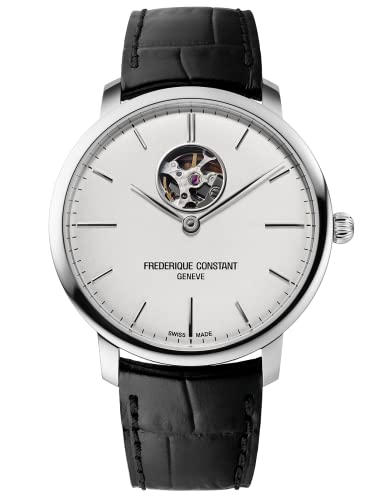Picture this – you’re standing in a watch store, mesmerized by the dazzling array of timepieces on display. Your eyes land on a luxurious open-heart dial watch, a true statement piece that exudes elegance and sophistication. But as you reach for your wallet, a question lingers in your mind: Are open-heart dial watches more expensive than regular watches? In this blog post, we aim to unravel the mystery behind the price disparity and delve into the factors that contribute to the cost of these captivating timepieces. So, whether you’re a watch enthusiast or simply curious about the world of horology, join us as we explore the intriguing realm of open-heart dial watches and their impact on your wallet.
Timeless elegance meets mechanical precision
What are open-heart dial watches?
When it comes to timepieces, there are countless options to choose from. Different styles, materials, and complications cater to various tastes and preferences. One type that has gained popularity over the years is the open-heart dial watch. In this blog post, we will delve into the details of open-heart dial watches, explaining their unique design and why they have become a favorite among watch enthusiasts.
1. Understanding the concept
Open-heart dial watches are known for their distinctive feature: a partially exposed mechanism. Unlike traditional watches that hide their intricate movements beneath a solid dial, open-heart dial watches provide a small window, revealing the intricate workings of the watch’s internal components. This allows the wearer to admire the beauty of the mechanical artistry inside.
2. The allure of visual complexity
The primary draw of open-heart dial watches lies in their visual complexity. By exposing the mechanism, the watch showcases the intricate ballet of gears, springs, and balance wheels that power its movement. This captivating display not only adds a touch of elegance but also serves as a reminder of the intricate craftsmanship behind the watch.
3. Aesthetic appeal
Open-heart dial watches offer a unique aesthetic appeal. The exposed mechanism adds depth and visual interest to the dial, creating a captivating focal point. This aesthetic enhancement can elevate the overall appearance of the watch, making it a statement piece for watch enthusiasts and fashion-forward individuals alike.
4. A lesson in watchmaking
For those with an interest in horology, open-heart dial watches provide an educational experience. By observing the movement in action, enthusiasts can gain a deeper understanding of the intricate mechanics involved in timekeeping. It allows wearers to appreciate the precision and skill required in crafting these timepieces.
5. Attention to detail
Open-heart dial watches showcase the meticulous attention to detail that renowned watchmakers invest in their creations. The exposed mechanism lays bare the intricate design and finishing touches, illustrating the level of craftsmanship that goes into every single piece. This attention to detail demonstrates the dedication of watchmakers in creating timepieces that are not only functional but also works of art.
Comparison with traditional watches
| Open-heart dial watches | Traditional watches |
|---|---|
| Exposed mechanism | Concealed mechanism |
| Visually complex | Simplified design |
| Unique aesthetic appeal | Classic and timeless |
| Educational experience | Standard functionality |
| Showcases craftsmanship | Focuses on aesthetics |
Open-heart dial watches represent a departure from traditional timepieces in several ways. The table above highlights some key differences between open-heart dial watches and their conventional counterparts.
In conclusion, open-heart dial watches are a blend of mechanical artistry and aesthetically pleasing timepieces. With their partially exposed mechanism, these watches offer wearers a captivating view into the intricate workings of the watch. They serve as a testament to the craftsmanship and attention to detail that go into creating such remarkable timepieces. Whether you are an avid horology enthusiast or simply appreciate unique design, an open-heart dial watch is sure to add an unmatched elegance to your collection.
Factors influencing the price of open-heart dial watches
Open-heart dial watches have gained popularity amongst watch enthusiasts for their unique and captivating design. These timepieces showcase the intricate inner workings of the watch, exposing the movement and adding a touch of elegance and sophistication to the overall design. However, the beauty and complexity of these watches come at a higher price tag compared to regular watches. In this blog section, we will dive into the factors that contribute to the higher price of open-heart dial watches, shedding light on the craftsmanship, movement complexity, and premium materials used.
Craftsmanship at its Finest
Craftsmanship plays a crucial role in determining the price of an open-heart dial watch. The intricate design and detailing involved in creating an open-heart dial require years of experience and skill from master watchmakers. Here’s how craftsmanship impacts the price:
- Hand-Assembly: Open-heart dial watches often involve meticulous hand-assembly by skilled watchmakers. Every component needs to be carefully examined, fitted, and adjusted, increasing the labor-intensive nature of the manufacturing process.
- Finishing Techniques: The visible parts of the movement must undergo various finishing techniques, such as bevelling, polishing, and engraving. These techniques ensure a flawless appearance and add value to the overall aesthetic appeal of the watch.
Comprehending the Complexity of Movement
The movement of a watch refers to its internal mechanism, responsible for its accuracy and functionality. The complexity of the movement significantly affects the price of an open-heart dial watch. Let’s delve into the factors that impact the movement’s complexity:
- Open-Heart Module Integration: Creating an open-heart dial watch involves integrating a special module into the movement, which allows for the display of the intricate components. This additional layer adds complexity to the movement construction and increases the price.
- Accuracy: Achieving high precision and accuracy in timekeeping necessitates the use of more intricate movements, such as automatic or mechanical movements. These movements are typically more expensive to produce than quartz movements.
- Number of Components: Open-heart dial watches often comprise a higher number of components compared to regular watches. The intricate arrangement of gears, springs, and other elements demands greater precision and R&D efforts, contributing to the overall price.
Premium Materials for a Timeless Appeal
The use of premium materials further elevates the price of open-heart dial watches. High-quality materials enhance the durability, aesthetics, and overall value of these timepieces. Let’s explore the impact of premium materials on the price:
- Case Materials: Open-heart dial watches are often crafted from premium materials such as stainless steel, titanium, gold, or even platinum. The choice of case material affects the overall durability and weight of the watch, amping up the price.
- Sapphire Crystals: Open-heart dial watches typically employ sapphire crystals for both the front and back of the watch. This scratch-resistant material offers exceptional clarity, allowing a clear view of the movement, but also adds to the price of the timepiece.
- Straps and Bracelets: High-quality straps and bracelets made from materials like leather or stainless steel not only enhance comfort and durability but also lend a sophisticated look to the watch, contributing to the overall price.
Price range of open-heart dial watches
If you’re in the market for a sophisticated timepiece that showcases the intricate inner workings of a mechanical watch, an open-heart dial watch is an excellent choice. These watches feature a cutout or aperture on the dial, revealing the mesmerizing movement of the watch’s mechanism. They are not only a testament to precision engineering but also add a touch of elegance to any wrist. In this article, we’ll delve into the different price ranges available for open-heart dial watches and explore what you can expect at each price point.
1. Entry-Level Options
For those looking to explore open-heart dial watches without breaking the bank, there are several entry-level options available. While these watches may come at a more affordable price point, they still provide an opportunity to appreciate the craftsmanship behind them. Here are some key features of entry-level open-heart dial watches:
- Price Range: $100 – $500
- Movement Type: Quartz or Automatic
- Materials: Stainless steel or entry-level luxury materials
- Features: Basic complications such as date or day indicator
- Brands: Seiko, Orient, Tissot
- Pros:
- Accessible price point
- Wide range of design options
- Suitable for casual or everyday wear
- Cons:
- Less intricate movement compared to luxury counterparts
- Limited premium materials and finishing options
2. Mid-Range Choices
In the mid-range segment, you’ll find open-heart dial watches that strike a balance between affordability and quality. These watches generally offer superior craftsmanship and finer materials compared to entry-level options. Here’s what you can expect from mid-range open-heart dial watches:
- Price Range: $500 – $2,000
- Movement Type: Automatic
- Materials: Stainless steel, premium leather straps, mid-range luxury materials
- Features: Additional complications such as chronograph or power reserve indicator
- Brands: Hamilton, Frederique Constant, Oris
- Pros:
- Increased attention to detail in movement finishing
- More refined designs and materials
- Improved accuracy and reliability
- Cons:
- Limited high-end complications
- Exclusivity factor may not be as pronounced
3. Luxury Segment
For those seeking the ultimate in prestige and craftsmanship, the luxury segment of open-heart dial watches offers unparalleled elegance and sophistication. These watches are crafted with meticulous attention to detail and boast exceptional movement complications. Here’s what sets luxury open-heart dial watches apart:
- Price Range: $2,000 and above
- Movement Type: Automatic, often with in-house calibers
- Materials: Precious metals, high-end luxury materials
- Features: Complications like moon phase, tourbillon, or perpetual calendar
- Brands: Rolex, Patek Philippe, Audemars Piguet
- Pros:
- Exceptional movement finishing and decoration
- Prestigious brands and heritage
- Limited edition and bespoke options
- Cons:
- Premium pricing
- Limited availability due to exclusivity
Comparing open-heart dial watches with regular watches
Watches are not just timekeeping devices; they have also become a fashion statement and a reflection of one’s style and taste. With so many options available in the market, it can be overwhelming to choose the right watch. One type of watch that has gained popularity in recent years is the open-heart dial watch. Open-heart dial watches offer a captivating view of the intricate movements inside the timepiece, adding an extra dimension of beauty and sophistication. In this section, we will delve into the comparison of prices between open-heart dial watches and regular watches, considering various factors to determine if open-heart dial watches are generally more expensive.
Brand
When it comes to watches, brand reputation often plays a significant role in determining its price tag. Many prestigious watch brands have started offering open-heart dial watches as part of their collections, and as a result, these watches tend to come with a higher price tag. However, it’s essential to note that there are also affordable open-heart dial watches available from lesser-known brands, providing an opportunity to own a unique timepiece without breaking the bank.
Materials Used
The materials used in the construction of the watch case, strap, and dial significantly influence its price. Open-heart dial watches, like regular ones, come in a variety of materials ranging from stainless steel, to gold, to exotic materials like titanium or ceramic. The choice of materials directly impacts the cost of the timepiece. Luxury open-heart dial watches often feature precious metal cases, high-quality leather straps, and sapphire crystal dials, thereby commanding a higher price. On the other hand, regular watches can also be found in a wide range of materials, both high-end and more affordable, catering to different budgets.
Movement Complexity
The complexity of the watch’s movement is another important factor to consider when comparing prices. Open-heart dial watches, by nature, showcase a portion of the movement through the dial’s aperture, allowing a glimpse of the intricate gears and mechanisms at work. This feature requires meticulous craftsmanship and careful assembly, leading to a more intricate movement design. Consequently, watches with open-heart dials often come with higher-priced movements, such as automatic or mechanical movements, compared to regular watches that may utilize simpler quartz movements.
Pricing Comparison
To provide a clearer understanding of the price differences between open-heart dial watches and regular watches, let’s summarize the key points with a comparison table:
| Aspect | Open-Heart Dial Watches | Regular Watches |
|---|---|---|
| Brand | Pricier options exist from prestigious brands, but more affordable options from lesser-known brands are available. | Wide price range, from affordable options to luxury watches from renowned brands. |
| Materials Used | Luxury open-heart dial watches often feature high-end materials like precious metals and sapphire crystal. | A wide variety of materials available, covering both high-end and more affordable options. |
| Movement Complexity | Open-heart dial watches typically feature more complex and prestigious movements, such as automatic or mechanical movements. | Regular watches may utilize simpler quartz movements or automatic movements, depending on the price range. |
From the comparison table, it is evident that open-heart dial watches can be more expensive than regular watches, particularly when considering prestigious brands and the complexity of the movement. However, it is crucial to note that affordable options exist for both types of watches, making it possible to find a timepiece that suits individual preferences and budgets.
In conclusion, the price comparison between open-heart dial watches and regular watches depends on various factors such as brand reputation, materials used, and movement complexity. Open-heart dial watches offer a unique aesthetic appeal, allowing wearers to appreciate the intricate craftsmanship behind the watch’s movement. While open-heart dial watches can be pricier, options exist across different price ranges, catering to a wide variety of watch enthusiasts. So, whether you opt for an open-heart dial watch or a regular one, the decision ultimately depends on personal preference, style, and the desired budget.
Final Verdict: The Pricing Comparison between Open-Heart Dial and Regular Watches
In conclusion, open-heart dial watches are generally more expensive than regular watches due to their intricacy and craftsmanship. However, the actual price range can vary greatly. Ultimately, choosing to invest in an open-heart dial watch should be based on personal preferences and budget constraints.















